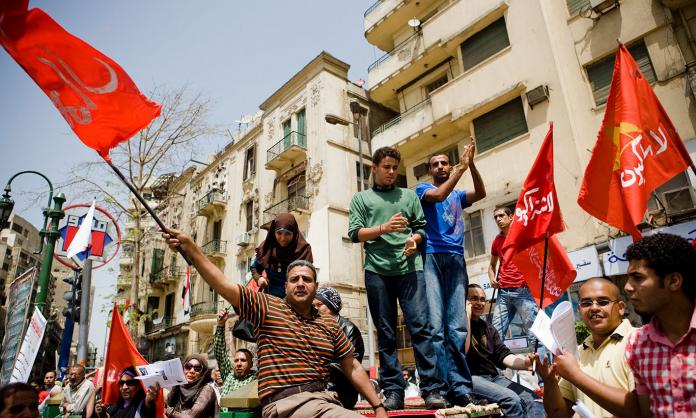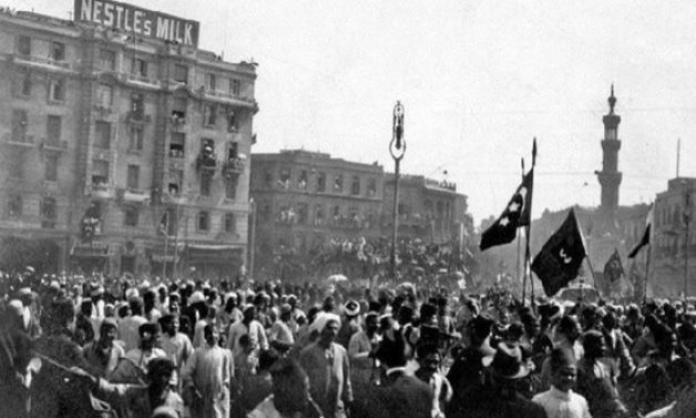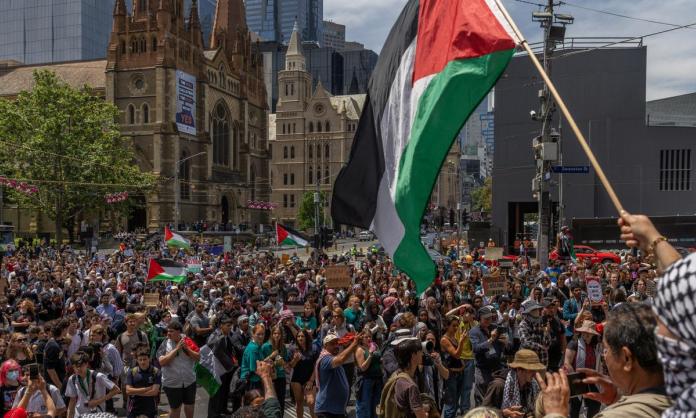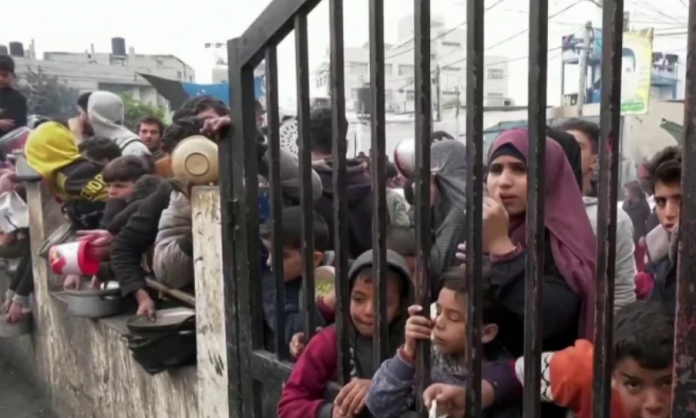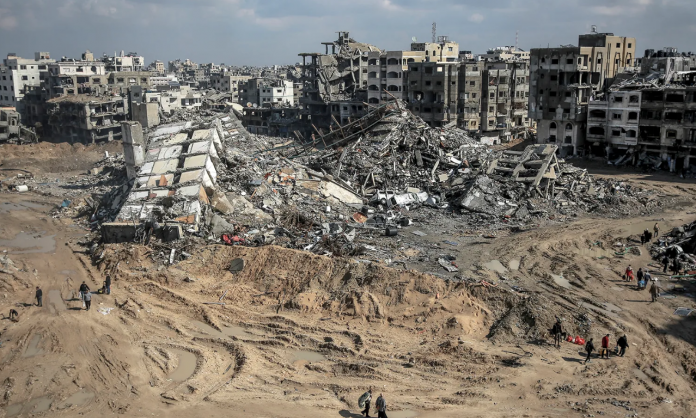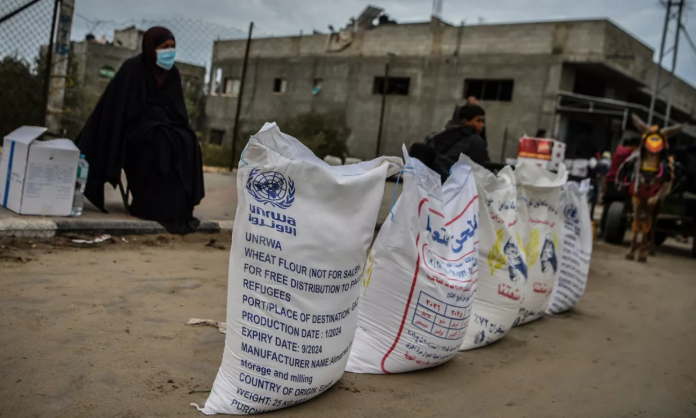Hossam el-Hamalawy is an Egyptian journalist, blogger and member of the Egyptian Revolutionary Socialists who has been an active participant in key struggles for three decades.
Hossam will be a featured speaker at the Marxism 2023 conference in Melbourne. In this interview, he speaks with Simone White about events that led to the 2011 Egyptian revolution, his radicalisation as a student in Egypt, and key lessons from the Egyptian revolution and counter-revolution.
Hossam, you were born in Egypt during the rule of Anwar Sadat, who initiated a neoliberal economic turn, cut ties with the USSR—Egypt’s main backer under Gamal Abdel Nasser—and signed a peace treaty with Israel. Can you talk about that period, what opposition there was to Sadat and how his rule shaped the terrain on which Hosni Mubarak became Egypt’s decades-long dictator?
When people talk about 1968, they are quick to point to the anti-Vietnam War movement in the US or the student occupations in Europe. But they forget that the Arab world had its own 1968. In Egypt, we had the first serious mass protests against Nasser since he consolidated his rule in 1954. These events revived the communist movement, which went on a trajectory that culminated with the 1977 “bread uprising”.
Egypt started its neoliberal reforms in 1974. The 1977 uprising signalled the beginning of the end of Sadat’s regime; he was assassinated by members of the Islamic Jihad in 1981.
Sadat was succeeded by Hosni Mubarak, who implemented the neoliberal “Economic Reforms and Structural Adjustment Program” under the sponsorship of the IMF and World Bank in the 1990s.
The neoliberal reforms went hand in hand with Egypt’s first “war on terror”—the militarisation of society and the securitisation of the social sphere. Basically, the state withdrew social supports, which left a vacuum then filled with repression, right throughout the 1990s. This was when I first joined university.
The regime initially targeted armed militants, but gradually shifted to the reformist Islamists, the professional syndicates and then to the left-wing activists. Egypt was going through a dirty war, almost Latin American style. As student activists, we could not mobilise protests that went off campus without risking being shot at. There was a general state of fear.
You could not whisper Mubarak’s name. You could not talk about Mubarak in phone conversations. If you talked politics in general, you always had to look behind your back in case there were informers or people who would snitch on you. It was a horrific environment.
Could you talk a little more about Egypt in the 1990s and 2000s and the kind of activism the left was involved in?
I belong to the second generation of Egyptian Revolutionary Socialists, who joined the organisation in the second half of the 1990s. And it’s my generation that started to revive and rebuild the left on the campuses. The turning point came in 2000 with the outbreak of the second Palestinian intifada. The Palestinian cause has long been a radicalising factor for Egyptian youth. For example, the 1968 movement in Egypt was triggered by the catastrophic defeat in front of Israel in 1967.
In September 2000, Egypt exploded with mass protests that started at the major universities, but soon spilled out to school students. There was a revival of street politics across the professional syndicates. The government responded with brute force; it rounded up student organisers on a mass scale. This was the first time I was detained and tortured at the hands of state security police. But I was luckier than others: I stayed for only four days in the interrogation centre in Lazuli, Cairo. The protests were crushed in about a week.
But they revived in 2002 with Operation Defensive Shield, when Israeli tanks were sent into the West Bank. This triggered the so-called Cairo University intifada, which culminated in two days of fighting across the Giza neighbourhood, which surrounds the university. We saw scenes that became familiar a decade later of police armoured vehicles trying to run over protesters, and tear gas and birdshots fired at us.
After these protests subsided, they were reignited with the invasion of Iraq in March 2003. The Palestine solidarity movement metamorphosed into the anti-Iraq war movement. At one point we had 40,000 protesters in running battles from old Islamic Cairo all the way to Tahrir Square. We took over Tahrir Square for a couple of days in what could be considered a dress rehearsal for the revolution a decade later.
Mubarak was a huge taboo at the time—you could not whisper his name. I recall during pro-Palestine protests on the campus in the 1990s, student organisers from Arab nationalist or Islamist backgrounds would tell me: “You Marxists, do not open your mouth about Mubarak. We don’t want trouble. We are here just to talk about Palestine”.
But this started to break with the intifada protests. In 2002, during the Cairo University intifada, I first heard explicit anti-Mubarak slogans. In 2003, Mubarak’s posters were burnt down in Tahrir Square.
The “Kefaya” movement, meaning “Enough”, came into existence in 2004. It was outright anti-Mubarak, and against the succession scheme for his son Gamal. Kefaya organised a series of anti-Mubarak protests in 2004, 2005 and 2006, but despite the heroism of activists, we must be clear about the base of support that Kefaya attracted. It was mainly middle-class activists, doctors, engineers, students, graduates, journalists like myself, pharmacists and even businessmen.
There was only one exceptional protest where we managed to pull together more than 5,000 people. But most of the time our protests were only about two dozen, 100 on a good day. But Kefaya managed to destroy the taboo of Hosni Mubarak via a media strategy. We contacted a wide variety of local and international journalists to show up to the protests. Through their cameras, they managed to disseminate those visuals to a wider audience.
Could you tell us about the growing struggle from 2006 onwards?
The December 2006 strikes, which were called the winter of labour discontent, started with 3,000 female government workers in the textile mill of Ghazel el-Mahalla, located in the heart of the Nile delta. It’s the biggest textile mill in the Middle East. They went on strike and started marching in the factory, demanding the two-month bonuses that were promised earlier by Prime Minister Ahmed Nhazif. The women workers were using a football chant that they had modified. “Where are the men? Here we are the women”, basically shaming their male colleagues into action. “You call yourself men? Here we are the women who are striking. Where are you?”
Their male colleagues joined them, the entire mill went on strike for three or four days, scoring a victory. As soon as they won, there were domino effects: the strike spread throughout the whole textile sector, especially in the north. And the industrial militancy started spinning over to other sectors, like the railways, the cement workers; everyone was going on strike.
These mobilisations were largely spontaneous. The Federation of Trade Unions was not a proper trade union, but resembled those that existed in the Soviet Union, of state-friendly bureaucrats who would act as the regime’s arm when it comes to controlling the workers and ensuring discipline in workplaces. The federation officials tried to sabotage the strikes, and the workers responded in some places by locking up their officials in the factory to force them to join the occupation.
In April 2008, when the Mahalla workers announced that they were launching a strike to demand raising the national minimum wage, the strike leadership was rounded up and the factory occupied, aborting the strike. However, the town of Mahalla erupted in a two-day uprising that was brutally put down by the central security forces. They killed three people, rounded up hundreds, torturing many of them, including children. But the Mahalla uprising signalled the beginning of the end of Mubarak’s dictatorship.
How was Mubarak overthrown?
Mubarak was exposed to be weak, with almost zero legitimacy. Every single sector in Egypt, except for the army and the police, were going on strike. It even reflected itself in pop culture. This Egyptian proverb “If you need something from the dog, you tell him you’re my master” was changed to “If you need something from the dog, tell him I’m staging a sit-in”.
Around this time, there was a growing movement against police brutality. Egyptian police are notorious for being horrible torturers. Torture is systematic; it is not only used against political dissidents, but even by the criminal police to solve crime.
There were protests against torture in the decade before the revolution, but the movement picked up when the police in Alexandria murdered Khaled Said, a young middle-class man, and photos of his body deformed by torture went viral over the internet, triggering an uproar at the time and an escalating movement that eventually ended up with the revolution a few months later. This was the summer of 2010.
The media at the time dubbed the revolution as the social media revolution. But we didn’t just bring people together because of social media. There was an entire decade of struggles, of small battles building up and dissent accumulating, before 25 January 2011.
The last point to mention is how Mubarak fell, because this has created so much confusion.
The eighteen-day occupation of Tahrir Square was brave and heroic. I was part of it, and I cherish every single moment that I lived in the square during that time. The square played a central role in bringing together revolutionaries with the mass of Egyptian people. We fought the regime, we fought the thugs that the regime sent us, we fought the police. But if it was only the occupation in the square, Mubarak would have survived.
Mass strikes started in the last week of the eighteen days. That’s when the regime was about to collapse. The army had to intervene to force Mubarak out of office to try to subdue this exploding mass of social protests and strikes. It’s very telling that the first law enacted after the fall of Mubarak was an anti-strike law by the Supreme Council of the Armed Forces, which took power after Mubarak was deposed. We need to stress the role of the working class in bringing down Mubarak, because this has implications for when the next revolution happens. We have to take Tahrir to the factories.
Hossam, what radicalised you? I’m assuming it was living under Mubarak’s rule?
Actually, no. I grew up in a middle-class family, so I was sheltered from the poverty that the majority of Egyptians live under. It was only when I became politically active that I experienced the brutality of the state. What radicalised me, and from a very early age, was the Palestinian cause.
You start watching and reading and hearing about what’s going on in Palestine. You start asking questions like: Why isn’t our government doing enough to help the Palestinians? Why is our government exporting cement to the Israelis that is used in building settlements? Why is our government allowing the Israelis to have an embassy in the heart of Cairo? Why is our government so submissive to the US and Israel?
The other source of radicalisation for me came from my father, who was raised as a staunch supporter of Nasser until the 1967 defeat. After this, he was radicalised further to the left and became very close to the communists. I used to have long chats with my dad, which opened my political horizon.
If we go back to when you were politically active at university, can you talk a bit more about what rebuilding a left on the campuses looked like in your youth? And what was the dominant politics on the campuses in the 1990s?
When I started university, the left had collapsed on all the campuses. There were the remnants of some of the old Stalinist organisations, but they were going extinct at the time, and they were going extinct for the same reasons that were making it difficult for us, as Trotskyists, to try to revive the left. The fall of the Soviet Union unleashed a tornado of right-wing ideas and discourses. This was the heyday of the end of history, the clash of civilisations and all these intellectual productions by Francis Fukuyama and Huntington and others, where socialism and class struggle were a thing of the past.
These discourses had an impact in Egypt. If you spoke about socialism, people were very quick to say things like “Oh, like what happened under Nasser? Do you see the public sector and how it is performing? You know, the economy is in shambles”.
In the West, people fantasise about the Global South, that it’s easier to have a revolution there. But we have our own problems, and not just state repression. I lost count of how many times when we were doing a stall on campus and trying to argue with students, they would ask: “When was the last time this country witnessed a revolution? You know, the Egyptian people, they will never rebel. They love to be ruled by the whip. Look at the pyramids. We have always been glorifying our pharaohs and our leaders. This country never saw any revolts”.
The dominant forces on the campuses at the time were the Islamists. This includes the reformist wing of the Islamists, the Muslim Brotherhood, who were very hostile to the left. The first time I was physically assaulted on campus for political reasons was not by campus security; it was by Muslim Brotherhood activists.
The kind of left that we were arguing for was a break away from the tradition of Stalinism, which meant we didn’t really have a tradition to build on, because in the past Trotskyist organisations in Egypt were small, not very effective, and had gone extinct long ago. We had to do so much trial and error. We did many stupid things, we did immature things, but we were learning at that time.
The reality of the counter-revolution in Egypt is obviously terrible. As we know, things are worse now than they were under Mubarak’s dictatorship. Can you talk about the most important lessons from the revolutionary uprising and the counter-revolution?
The first lesson would be never to trust the military. This might sound obvious, but we had to argue fiercely with others that the military is not on our side. Even though it’s dependent on conscription, and it might have my brother and your cousin, it’s still not on our side.
The second lesson is that you must organise in advance. There is no shortcut. Spontaneity is not enough. In the beginning of the revolution, anyone can call for mass mobilisations. Anyone could have jumped on Facebook and written “Let’s have a protest now”, and they would get people. But this cannot be sustained for a long time. The revolution taught me that even a small organisation like ours (when we started the revolt, we were dozens of cadres surrounded by hundreds of members) can punch above its weight if it is properly organised.
No matter how small you are, you can always punch above your weight in a revolt. Imagine if you were entering this uprising already a big organisation. I’ve learned hundreds of things throughout the revolt, but I would say that this is what would make or break it: whether you’re organised enough or not.




